Pioneering Women
-
Aitken, Grace Elaine
Grace Elaine Aitken  Ancestry
Ancestry
b. 5 Aug1895, Bickley, Kent
Father: Robert Bruce Aitken, a solicitor (qualified 1885), mother Harriot(t) (Soames, d. 1963 aged 100). They married 12 Jun 1894.
Sister Kathleen Maud, b. 1897
Robert was an RAF 2nd Lieut 1917-18, and d. 21 Nov 1942 in Llandudno.
In the 1911 Census Robert and Harriot lived in Tunbridge Wells with their 4 servants; Grace, age 15, meanwhile was at boarding school - St Felix School, Clogle House, Reydon, Southwold.
Grace qualified as a masseuse (in Medical Gymnastics and Medical Electricity) and travelled to Quebec in 1926, New Zealand in 1927, and Hawaii and the USA for three weeks in 1928.
Her address by then was Masons Bridge Hall, Salfords, Horley, Surrey (which is near Redhill Aerodrome).
'Flight' Magazine recorded the start of her aviation career in October 1929: "During this week, three new lady members commenced instruction; they were Miss M. M. Noakes and Miss M. J. M. Turner, of Maidstone, and Miss G. E. Aitken, of Horley, Surrey. It is very encouraging to see the increasing interest and enthusiasm with which ladies are taking up flying."
The following year, she gained her Royal Aero Club Certificate No 9123, at the Cinque Ports Flying Club based in Lympne, Kent

She acquired a 1930 DH.60M Moth, G-AAWX, from Sir Piers GJ Mostyn.
For the next couple of years, she was an ever-present face in aviation circles, and 'Flight' recorded her various activities and triumphs:
May 1931: "The chief event of the afternoon was a race for ladies, this was divided into heats with Miss Aitken, Miss Crossley and Miss Amy Johnson in the first, and Miss Burr, Miss Gower, Miss Giles, Mrs. Young, Miss Slade, and Miss Spooner in the second. The winner of the first heat was Miss Amy Johnson, with Miss Aitken second, and of the second heat Miss Burr, followed by Miss Gower.

Amy, Pauline, Dorothy, Gabrielle, Susan, Winifred, and Delia
These four then took part in the final, which was a victory for Miss Aitken, with Miss Gower second, Miss Johnson third, and Miss Burr fourth. Capt. Dancy', that king of handicappers, was once again to be seen, complete with stop watch, red flag, and gum boots, and his work augured well for future races this year. Only a few seconds separated the winners in each heat, although the speeds of the machines varied widely, and the final was a masterpiece of handicapping, only ten seconds covering those racing.

The course was a triangular one around Wokingham Church and Twvford Station, the heats being one and the final two laps, the latter being about 20 miles."
July 1931: "Two of the Club's lady private owners, Miss Aitken and Miss Giles, left for Paris on Thursday in their two Gipsy Moths. It was originally their intention to tour Germany, but the political and financial situation there made this inadvisable."
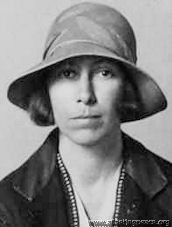 Joanna Elder Giles
Joanna Elder GilesAugust 1931: "A remarkably good performance was put up by two of the Club’s lady private owners, Miss Aitken and Miss Giles, who returned on Thursday July 30, from a fortnight’s flying four of France, covering a very big mileage during the period. They expressed themselves very pleased with the courtesy extended to them on all the friendly aerodromes on which they landed, and were particularly impressed by the French Meteorological Service."
September 1931: "In the last week’s report reference was made to Miss Aitken. one of the lady private owner members, and the hope was expressed that she had won the Ladies’ Cup at the St. Hubert Rally; this has proved to be the case, and, in addition, she has won the Challenge Cup, to be held by the Club for 12 months; this is an extremely meritorious performance and the Club offers her its sincere congratulations."
October 1931: "Lt. Com. T. S. B. Gubbins inaugurated his new flying field at Barham, and the informal opening was attended by Miss Aitken in her own aircraft."
November 1931: "On Sunday a party was held to celebrate the arrival of the ‘Coupe Challenge Internationale" - won recently by Miss Grace Aitken, of this club, on the occasion of the Second International Rallye at St. Hubert, Belgium. The cup, which stands ever 2 ft 6 in, high, is of solid silver on a marble plinth, and is held by the Club for a year; a replica is held by the winner.
Miss Aitken was the Club’s first lady ‘A’ licence pilot, and deserves the hearty congratulations of all on her extremely meritorious performance and her successful efforts to uphold the prestige of British amateur aviation on the Continent of Europe. Among those present at the celebrations were Miss J. E. Giles, Miss M. Noaks, Mrs. Hammond Davis, Mrs. H. E. Twaites, Lt. Com. G. S, B. Gubbins, Messrs, Drake, Marriage, Searle, Waller, Morris and Twaites, and other members and friends. The cups referred to were collected by aeroplane from the town of St. Hubert on the 18th ult. by Miss Aitken in person."
May 1932: "Several club members went over to the Antwerp meeting, including the Misses Aitken and Giles and Messrs. Trewlawny, Waller and Gubbins."
August 1932, the "GOSSIP FROM GATWICK" was that "The feminine element was well to the fore during the last week. Miss Aitken did her first taxi trip, when she conveyed Miss Sewell to Heston to collect her machine, in which she put up such a very good show when she flew it out solo to Transjordania."
September 1932: "A WOMEN'S FLYING MEETING
The Womens Engineering Society, who at the suggestion of Lady Bailey have formed an aviation section, held an air meeting in connection with their Tenth Annual Conference at Atlantic Park, Eastleigh, near Southampton, on Sunday, September I5. Owing to a very regrettable streak of misplaced Puritanism on the part of the municipal authorities, the organisers were not allowed to bring the general public into the meeting, except free of charge, with the result that they had to content themselves to a small but select party of invited guests.
Atlantic Park is quite an excellent aerodrome, and we hear rumours that it may shortly be the home of one of the well-known South Coast flying clubs. The hangars are still in reasonably good repair and bear romantic evidence, in the shape of notices in many languages, of the days when the shipping companies had perforce to use it as a dumping camp for the crowds of European emigrants who fled their own countries after the war to seek fortunes in the USA. (who knows but what it may have sheltered Scarface Al or others of his ilk!). Visitors by air had, we gathered a very sticky trip, as the clouds were down on the hills in most parts of the country and this kept the numbers of aircraft very low, but those who came by road fared better for despite rain which made things unpleasant they had no difficulty in finding the way ; AA notices at every corner led them straight to the aerodrome. — Mr. Ivor McClure, who has made the aviation department of the A. A. what it is, surely deserves recognition as one of aviation's benefactors.
The Dowager Lady Swaythling opened the meeting and the women who had flown down were presented to her. These included Miss Aitken Mrs. Victor Bruce, Mrs, Chalmers, Miss Spicer, and Lady Bailey. Mrs. Shelmerdine, who had nobly come all the way from London by road, Mrs, Mollison, who arrived somewhat later in her special 'Moth' and last, but not least Miss Mollie Ofley, of the Northamptonshire Aero Club, to whom had been entrusted the organisation of the dying programme of the meeting."
In September 1932, there was a "LADIES’ PARTY AT SYWELL
On Sunday, September 25, the ladies of the Northamptonshire Aero Club held the second of their annual flying meetings. This year the meeting, once more ably organised by Miss Mollie Ofley, was more in the nature of a garden party, the general public not therefore being invited. Some dozen visiting machines arrived at the aerodrome during the afternoon, quite a large proportion of which were flown by lady pilots. Unfortunately, other meetings in the country clashed with this gathering, thereby lessening the number of visitors. Last year the handsome cup presented by Mr. Lee Champion, was won by Miss 'Susan' Slade in a race which, it will be remembered, was distinctive for its somewhat exciting(!) finish. This year however, the idea of a race was abandoned and a competition substituted. The cup, it was decided should still be presented to the winner and therefore Miss Slade had perforce to fly up from Cornwall w ith this 'utensil' which she managed to do despite the execrable weather. Miss Slade told us that she explored every valley in Somerset in an endeavour to get north from Cornwall on the first day of her attempt before returning to a field belonging to some friends in Taunton. On the second day she was more lucky, and by avoiding the hills she was able to get through.
The competition took the form of a test of the pilot's ability to fly accurately by compass without the aid of a map. All entrants were given maps. but these were sealed and the breaking of the seal entailed disqualification. Four bearings and distances were given with landmarks, which had to be noted at each comer, observers being stationed at these marks. As a precaution against the eventuality of several competitors getting round the course correctly they had, on their return to the aerodrome to land, finishing their landing run with their wheels as near to a line of flags as possible. Points being deducted according to the distance they were from these flags.
The entrants included Miss Susan Slade, Lady Bailey, Miss Giles, Miss Muntz and Miss Aitken.
A scientific scheme of marking was evolved by several of the enthusiastic male members of the club, and the result of their labours was to award Lady Bailey 66.25, Miss Giles 63.5, Miss Slade 62,5, and Miss Muntz 61.25. Unfortunately, Miss Aitken decided that if she continued looking for the landing marks any longer she would be in danger of losing her tea, and she therefore opened her maps, which, of course, entailed her disqualification."
And then her flying career seems to have ended. She sold the Moth to Robert Christian 'Bob' Ramsay...
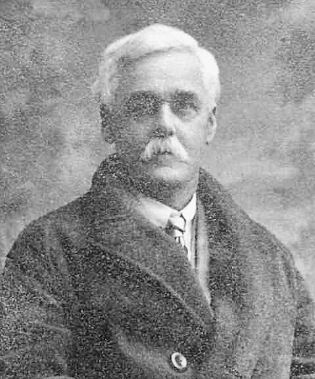
... and in 1933, she married Kenneth Minshull Robathan (1 Sep 1889 – 2 Feb 1965) who was an English first-class cricketer, British Indian Army officer and clergyman, and held ecclesiastical appointments at Dethick, Lea and Holloway in Derbyshire, Lee-on-Solent in Hampshire, and Potterne in Wiltshire. He died in February 1965 at Ringwood, Hampshire.
They had 2(?) children.
Grace was still practising as a masseuse in Matlock, Derbyshire, in 1946.
She died 14 Feb 1979 giving her address as Camel Cross Motors, West Camel, Yeovil Somerset, leaving £78,183
-
Anderson, Elizabeth Ann Roche
Miss Elizabeth Ann Roche Anderson
Royal Aero Club Certificate 8735 (26 Jun 1929)
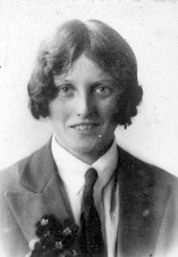
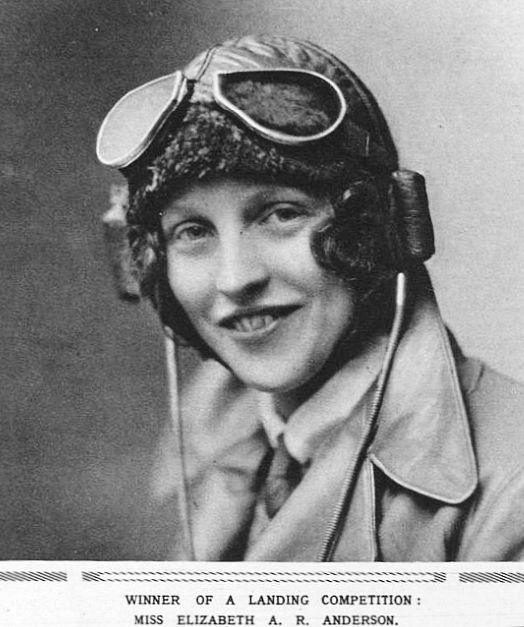
The Sketch - 1929
b. Dullatur Scotland, 18 Aug 1908
A Masseuse
-
Bagge, Nancy Adelaide
Nancy Adelaide Bagge 
b. 5th October 1907 in King's Lynn, owned a 1930 Klemm L25 Ia, G-AAUP. She was the second of five daughters of Sir Richard Ludwig Bagge and Anna Victoria Wilmsdorff Mansergh, lived in Gaywood Hall and married Captain George Cecil Pereira on 1 March 1934. -
Bailey, Mary
Hon. Lady Mary Bailey
Royal Aero Club Certificate No. 8067 (26 Jan 1927)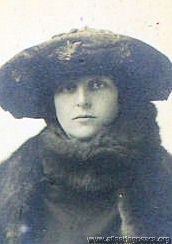 1927, aged 37
1927, aged 37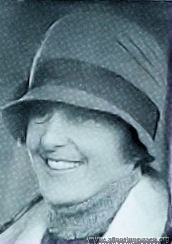
1930, aged 40
The Hon. Mary Westenra, b. 1 December 1890 in London but brought up mainly in County Monaghan, Ireland.
Her family's home was Rossmore Castle, which was a grand affair built in the 1820s, with turrets, a vast drawing room and servants' quarters, not to mention about 20 cottages on the estate:
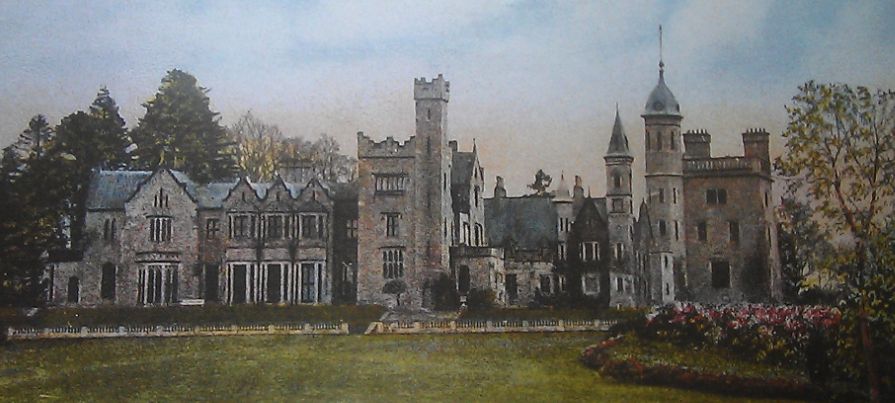 www.monaghan.ie/museum
www.monaghan.ie/museumHere she is, with her brother Willie, and parents (Mittie and Derry) on a set of steps by the house, in 1913:
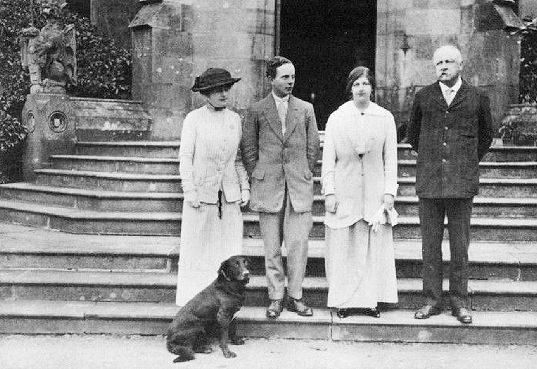 Throttle Full Open
Throttle Full OpenI visited County Monaghan in 2014 and asked in the local museum if they knew where the house was. 'Oh yes' they said, 'but it was demolished forty years ago'. It seems that it became severely infested with dry rot in the 1940s, was abandoned and, indeed, demolished in 1975.
Anyway, here's all that's left of it now:
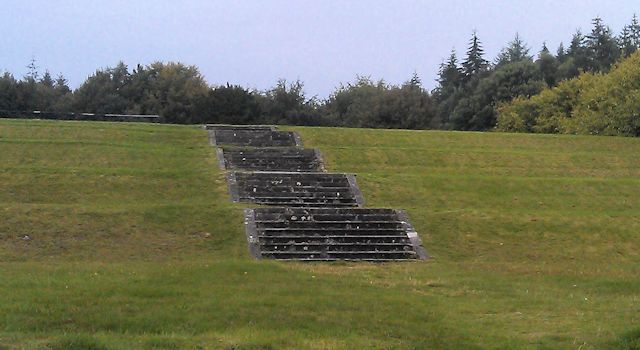
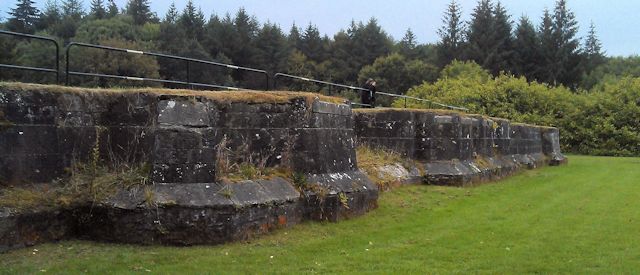
Mary married South African mining magnate and white suprematist politician Sir Abe Bailey in September 1911 (so, she was 21, he was nearly 47; his first wife had died in 1902 and he already had two children). They then had five more children - 2 boys and 3 girls.
She learnt to fly at the London Aeroplane Club in 1926. She was the first woman to fly across the Irish Sea 'by the long route' from Chester to Dublin, the following August.
The following March (1928) she began a solo tour to Cape Town, via Malta and then Cairo. Here, her plane was locked away by order of the Governor-General of the Sudan to prevent her from continuing alone, so she contacted Dick Bentley (who had flown to the Cape a few weeks before) to escort her in his own aeroplane over the "dangerous area of the southern Sudan". She then crashed in Tanganyika, writing off her aeroplane (she said it was her fault), but Abe made arrangements for a replacement Moth to be delivered from Pretoria and she continued, despite having 'flu. Abe was there to meet her when she arrived at the end of April.
The return journey was made via the western 'French' route - the Belgian Congo, Angola and the French Congo. She finally arrived back at Croydon on 16 January, 1929, 10 months after she left. It was "undoubtedly one of the finest performances ever put up by a woman pilot."
Lady Bailey was "so modest, so vague and so charming", and was "surprised that anyone should make a fuss about her journey".
A Director of National Flying Services in 1929, (with Frederick Guest, Colonel the Master of Sempill, Alan Cobham, etc); she was also awarded the Brittania Trophy by the Royal Aero Club, and then made a Dame of the British Empire in 1930 for "services to aviation".
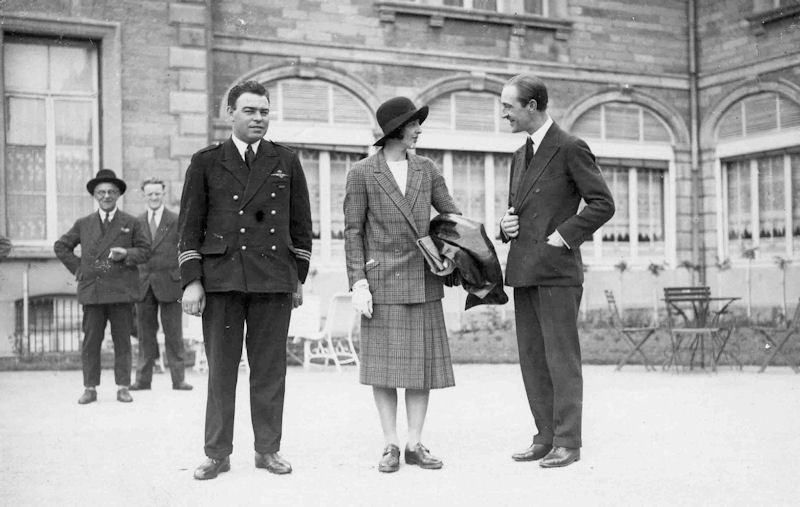
At the Chateau d'Ardennes in 1930
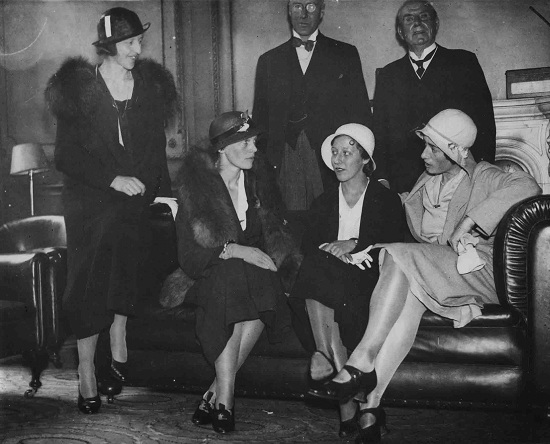
She was a guest at Amelia Earhart's reception at the Royal Aero Club in May 1932.
In early 1933 she gave everyone a scare by disappearing for several days on another solo flight to Cape Town; thankfully, she had only got lost, run low on fuel and landed safely in the Sahara. [Bert Hinkler, who disappeared at about the same time, was killed in the Alps]. She then flew back to England and almost immediately went down with a bout of typhoid, but recovered in time to compete in the King's Cup later in the year.
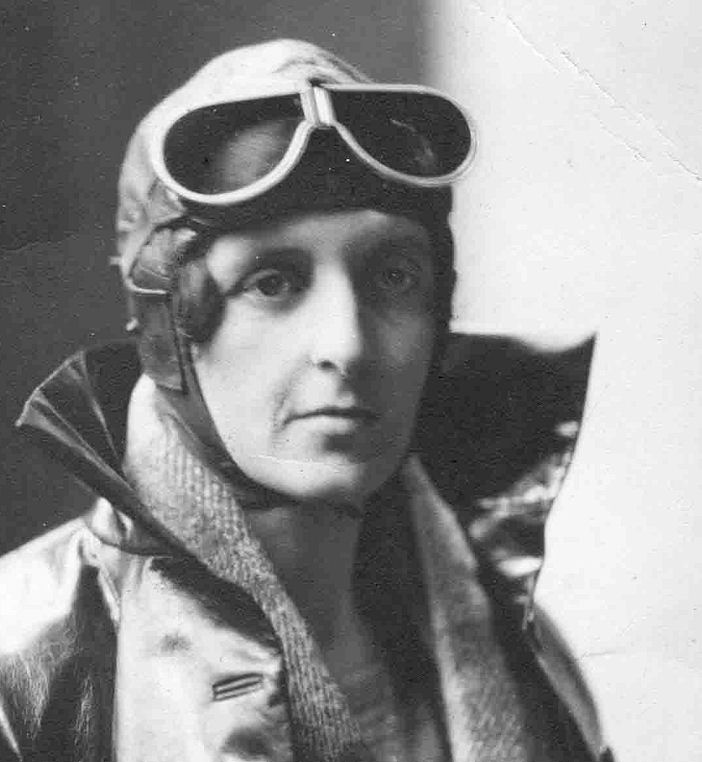
After that, she concentrated on looking after their horses, giving and attending loads more balls and receptions, and marrying off their many children.
When Abe died in 1940, she settled near Cape Town (still keeping a house in Rutland) and died there 29th August 1960 aged 69.
Lady Mary's aeroplanes were:
a 1926 DH.60 Moth (G-EBPU),
a 1927 DH.60X Moth (G-EBSF, the one she crashed in Tanganyika),
the replacement DH.60X Moth (G-EBTG, which Abe bought in Nairobi);
a 1928 DH.60G Gipsy Moth (G-AABN);
a 1929 DH.60G Gipsy Moth (G-AAEE) and
a 1930 DH.80A Puss Moth, G-AAYA.
-
Baring, Violet
Violet Baring
Royal Aero Club Certificate 8932 (17 Dec 1929)
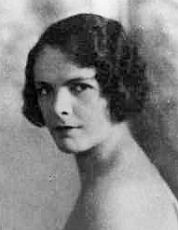 1929
1929b. 1900
b. Violetta Mary Archer in Reading, "A niece of Lady George Dundas, of Newmarket, and also of the Marquess of Zetland."
Married Richard Baring in Jan 1921 but 'divorced him'.
Violet was killed in July 1931 when she and her 'old friend' Philip Noble (to whom she had just sold the aeroplane) crashed in G-EBYK while attempting a forced landing near Wokingham, Berks:
"The woman pilot, who was well-known in Society, and her passenger, a director of Lloyds Bank, who was also an enthusiastic flyer, were killed instantly; both receiving terrible injuries."
John Dennis Turner (q.v.), who said he was engaged to be married to Violet, identified the body and gave evidence at the inquest.
Her house at 23 Earl's Court Square, London, was for sale 'at a low price' by the following January.
-
Brown, Winifred Sawley
Miss Winifred Sawley Brown
Royal Aero Club Certificate No. 8091 (6 Apr 1927)
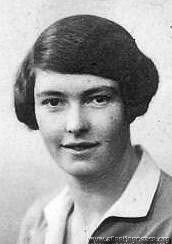 photo: 1927, aged 28
photo: 1927, aged 28 .jpg)
b. 26 November 1899 in Brooklands, Cheshire; her father was director of a firm of butchers.
She said she learnt to roll her own cigarettes at the age of five; expelled from school at age fourteen (for writing 'the headmistress can go to hell' on the toilet wall), she made her first flight in 1919 from Blackpool sands.
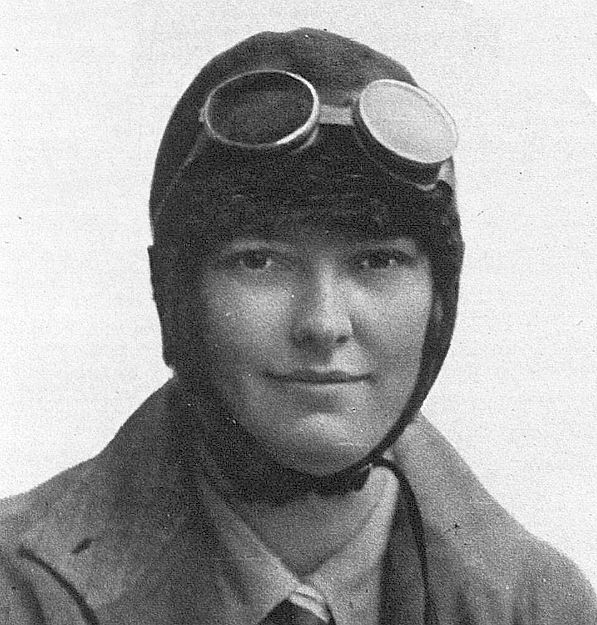 "A Well-known English Pilot" - The Sketch, 1929
"A Well-known English Pilot" - The Sketch, 1929First woman to win the King’s Cup (in 1930); well known in Lancashire as a hockey player who kept goal for the county and toured Australia with an English team; also a pretty good golfer, sailor and tennis player.
To see her being thoroughly embarrassed by her reception back at the Lancs Aero Club after winning the King's Cup, and to hear her say “Thank you for this welcome, it’s awfully good of you and I’m awfully happy to be back again in Lancashire, at the aerodrome where Captain Brown taught me to fly…. I’m delighted to have won the race and, well, thank you all very very much, I can’t say any more”, see here
.jpg)
Her son, Tony, b. 11 December 1940 in Angelsey, is "loved and remembered by millions as slippery Adam Chance in Crossroads".
She owned:
the 1928 Avro 594 Avian III, G-EBVZ - which her father bought for £500 - in which she won the King's Cup in 1930, then
a 1930 Avro 616 Sports Avian, G-ABED.
'Win' died in July 1984 in Hove, Sussex.
And you can now get a proper biography, entitled "WINIFRED BROWN: Britain's Adventure Girl No. 1", written by King's Lynn's most famous living author, Geoff Meggitt.
See www.pitchpole.co.uk for details!
b 26 November 1899 in Brooklands, Cheshire; her father was director of a firm of butchers.
Learnt to fly in 1926, but in 1928 was the pilot in a horrific accident when she was duped into a publicity stunt by Walter Browning, the 'Dancing Airman', who told her a film had to be delivered urgently, and persuaded to land her Avian in a field. She was surprised to see a crowd of people, realised she wasn't going to stop in time and tried to take off again, but hit the crowd standing near a wall; a 10-year old boy was killed, several persons injured, and "many women fainted". It turned out that the 'urgent film' never existed, just an empty box. She was exonerated of any blame.
First woman to win the King’s Cup, in 1930. She became an instant star across the world, especially in her home city of Salford. Invited to the 1930 Historical Pageant at Buile Hill Park shortly after the race, crowds chanted for a speech to be made. Winifred said “This is really wonderful of you all, I am very glad to belong to Salford” which prompted one audience member to start a sing along of ‘for she’s a jolly good flyer’. The Mayor of Salford congratulated Winifred on behalf of the people, and joked “No man begrudges you your honour and you have put us all back in our place”.
Before the Race, she was "well known in Lancashire as a hockey player who keeps goal for the county and has toured Australia with an English team".
One of the guests of honour at the Ladies Night dinner of the Press Club in December 1930; the chairman reckoned that "Women had forced their way into the columns of the Press, and now they seemed to be on the way to monopolizing them".
She was still an active ice hockey player in 1933, flying herself from Manchester to London to take part in the Sheridan Cup, where she kept goal for the "Queen's Ladies". She was also a pretty good golfer; she and her partner Mrs Brooks got to the last 8 of the Ladies' Northern Foursomes at Leeds in 1938.
Later sailed from North Wales to Spitsbergen in her 45-foot yawl Perula. During WWII, Chief Coxswain in the Marine Department of Saunders Roe.
In 1940 she gave birth to a son, Anthony, after it was revealed she had "secretly married her long time adventure companion Ron Adams" (although I'm not sure what was so secret about it).
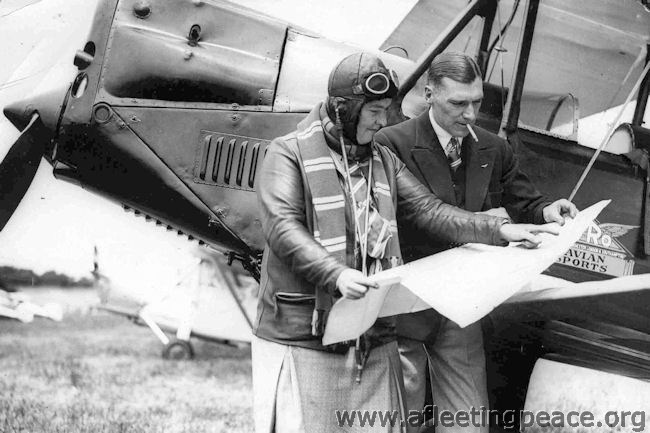
She attended the 1950 King's Cup Race, but was "horrified ... I thought sadly of Bert Hinkler, Cobham, Barnard, Hubert Broad and Wally Hope."
'Win' died in July 1984 in Hove, Sussex.
Winifred Brown was born [26 November] 1899 in Brooklands, Cheshire. She moved to Salford at an early age and went on to attend ‘Bella Vista’, Broughton High School for Girls. Winifred’s father, Mr Sawley Brown, was director of Messrs. James S. Brown & Sons, a firm of butchers.
Winifred was a natural sportswoman, and achieved great success in flying when she became the first woman to join the Lancashire Aero Club in 1926 and the first woman in the region to qualify for a pilot’s licence in April 1927. By March 1928 Winifred was recruited to the rank of a private owner member, and that same year she won the club’s Rodman Trophy.
By the 1930 King’s Cup Air Race, a 750mile race around England, Winifred Brown was an experienced pilot, although she had never flown such a long distance. In the pre-race articles that appeared in Flight magazine, on June 13 1930,Winifred’s entry was not taken seriously, mentioned with six other pilots of the ‘fairer sex’ only briefly. Winifred flew an Avro Avian with a Cirrus III engine with her co-pilot, and later husband, John Ron Adams. The Air Race was full of excitement, after starting the race at Hanworth, London. By the time she reached Barton Aerodrome, Winifred was in third position and the large crowds roared with excitement. The final finish was at Newcastle, by which time she’d run away with the lead. There was a dramatic finish when Winifred spotted a large aircraft behind them. Believing it to be a competitor and determined not to be beaten to the finish line, the Avian was pushed to speeds of 160 miles per hour! Afterwards a mechanic told the Salford Reporter that this speed ‘was courting disaster’. By pushing her Avian to the limits Winifred beat her male contemporaries, including Flight Lieutenant Waghorn, winner of the prestigious Schneider Cup.
As the first woman to win the King’s Cup, Winifred became an instant star across the world, especially in her home city of Salford. Invited to the 1930 Historical Pageant at Buile Hill Park shortly after the race, crowds chanted for a speech to be made. Winifred said “This is really wonderful of you all, I am very glad to belong to Salford” which prompted one audience member to start a sing along of ‘for she’s a jolly good flyer’. The Mayor of Salford, Samuel Finburgh, congratulated Winifred on behalf of the people, and joked “No man begrudges you your honour and you have put us all back in our place”(Salford Reporter 11 July 1930).
Winifred’s later adventures in the 1930s went beyond Britain, this time sailing rather than flying from North Wales to Spitsbergen in her 45-foot yawl Perula. During the Second World War, Winifred worked as Chief Coxswain in the Marine Department of Saunders Roe, the flying boat constructors in Beaumaris. Winifred worked with a fleet of R.A.F. craft with all-male crews, she met Catalinas from Bermuda, landed and embarked crews and towed aircraft.
In 1940 she gave birth to a son, Anthony Sawley Adams, after it was revealed she had secretly married her long time adventure companion Ron Adams.
With thanks to John B. Coxon and Tony Adams
In 1950, Winnie wrote this lovely article for 'Flight':
POST-WAR AIR RACING - is Something Missing?
A Pre-war Winner Asks Some Pertinent Questions
By WINIFRED BROWN
As something "rather different" in post-war air races, the Daily Express "International South Coast Race" on September 16th seems likely to be watched with interest, especially by "the forgotten pioneers of long ago" - in which category a South African magazine recently included me!
For some time we have been asking ourselves " What has gone wrong - air racing or we old pilots?" Has the sport really lost its thrill and popularity, or have we merely become the club bores who stand at a bar counter and say, between beers, "Things aren't what they were"?
I have been thinking about these questions for several weeks - ever since, in fact, I set off, in excited anticipation and an Austin Seven - to see this year's King's Cup Race. The Wolverhampton Aero Club had very kindly invited me - "Just to show them you are still in the land of the living, Win?" chuckled John Bill over the telephone, for the previous year the B.B.C. had coupled my name with the type of wings that go with a harp! It was 20 years since I had won the King's Cup and 19 years since I have even seen an air race. I had a shock coming to me!
When asked if I were flying, I laughed and replied ungrammatically, "What, me! I'm used to 105 m.p.h.,not 501." And as my little car proceeded at a sedate 40m.p.h. my mind went back 20 years. Who would be there? Tommy Rose, Jimmy Jeffs, Robin Cazalet, "Lamps"? What fun it would be to see them all again!
On arrival at the Star and Garter I rushed to look at the hotel register... I didn't recognize a single name! They must still be in the bar... we had always lingered... they would come later; so, casting respectability to the wind, I ignored my married name and wrote " Win Brown and son."
That night there was a R.A.F.A. dance - to meet the "famous pilots"! The dancing was popular enough, but we were not; when we went on the stage the room practically emptied - the dancers had probably done far more flying than we had!
Still there was a nice bar upstairs, and I talked with interest to the 1950 pilots. "Do you have flying pageants these days?" I asked a young man. For a moment he looked puzzled, then replied "Yes, but we call them 'air rallies'". When I flew in 1930 we had a 750-mile course. Do you like these short circuits? " "Oh yes! It's a better test of flying—none of this navigation stuff enters into it. '
I thought sadly of Bert Hinkler, Cobham, Barnard, Hubert Broad and Wally Hope. That night I went to bed at 11.30 - if there was a party I didn't find it!
Next day I got to the airfield early. I looked and blinked. Was I back in 1930? Where were these modern super aircraft? I felt I could have got into almost any one of the competing machines, and flown as I used to do; but my son, aged nine, was thrilled as I took him round. It was then the Press descended on us - "That's right,sonny - smile up at your grannie!'' My expression was such that the pictures did not appear, but fortunately the bar tent opened and Jack Cantrill, who had given me my first flying lesson in 1925, assisted me to recover.
Then a few old faces appeared, but we all sadly agreed that "things ain't wot they was." As for the race itself - well, it sounded fine on the radio but, with no rudeness intended, I would not describe Hawk Trainers and Austers "screaming" round anything. Princess Margaret's Hurricane gave us a thrill and it was beautifully handled by Townsend, but the two Spits that I hadrelied on to impress my son promptly took off and got lost - so perhaps there is something in this ''navigation stuff" after all! One we never saw again, but the other obligingly returned, much to the delight of my small son, and the spectators - but probably less so to the owner of the aircraft whose tail it knocked clean off.
But what horrifies me about this race - and, for that matter, present-day air racing in general - is that the slide-rule experts, secreted with Charles Gardiner in glass towers, seem reasonably able to forecast the result after one lap! In the King's Cup they were about 60 yards out, and in the two Newcastle races a few weeks later it seems from Flight's report that the ultimate winners appeared unbeatable almost from the outset.
Where is the sport, the fight, the fun of the thing? It seems to me that if you haven't beaten the handicappers before you start you might just as well stay in the bar. On a long circuit a race was never lost until it was won. Engines could pack up in sight of home; flimsy racing wheels could buckle on a careless landing; you might run into cloud or fog and fail to find that white cross in the field; but no matter what happened there was always home - the others might be faring worse. To beat the handicappers was a decided help, but only the beginning of a long story.
After this year's King's Cup I scanned the newspapers, but gone were the old headlines. The little publicity there was went to the tragic accident rather than to Edward Day. I wondered vaguely if a victory for Princess Margaret would have received more publicity, but I doubt it - my papers were full of the footballers who received a free trip to South America, £25 each and the offer of some £175 a month, and returned highly incensed because a hair-cut cost 7s and the people carried rifles!
So good for British prestige, and obviously so much more important than a few men and women who risk their neck for British aviation, a possible prize of £150 and a replica of the Cup. I did risk my neck for about £1,000 in 1930, and in those days the cup was won outright.
What has caused this lack of interest on the part of the Press and public? Has flying become too common? But, for that matter, what could be more common than football and race-horses, sports which still hold the crowds? Perhaps it is the effect of the war - petrol only just off the ration, money short, private owners and aero clubs unable to afford the high-powered aircraft we now scarcely glance at as they do, literally, scream through the sky.
Presumably with the industry in a transition stage pending large-scale production of military jet aircraft, and because of present-day-economic conditions, the trade cannot give the support it did to racing. For this reason one must admire the present-day private owner. Gone are the days of dual at £1 an hour, free petrol, a loaned engine, and perhaps even a free aircraft. To-day one can hardly afford to patronize the bar tent!
My small son was all for presenting the King's Cup to Cole and his Comper Swift. ''That little one has done best, Win - t has gone all that way against the big ones." Out of the mouths of babes and sucklings.... Would the old Circuit of Britain again arouse public interest? Personally, I think it would. Some 15,000 people were present at Wolverhampton this year, but in 1930 similar, if not larger, crowds assembled at each of the controls at London, Bristol, Manchester, Newcastle and Hull, not to mention the turning-points at Southampton, Birmingham,Liverpool, Leeds and Leicester. The King's Cup race belonged to the country as a whole and not just to one area.
But there is another point, and an important one. The rot started to set in way back in 1931, when new King's Cup regulations caused the entries to drop from 101 to 41. Restrictions! They are ruining our country to-day. It seems to be that the South Coast Race is, in some degree, a return to old conditions, and that if it is successful it may influence next year's King's Cup. I hope so, for personally I would like to see a grand and glorious free for all - Maggies to Meteors on the old circuit of Britain.
''What else would you do, Win?" asked one of the old timers as we stood discussing the matter in the bar. "I'd have bookies under nice, coloured umbrellas - but I'd keep them away from the slide-rule experts!" And I suppose you'd have better prizes and bigger bar tents? "Sure!" I laughed. "Well," said an old pilot, slowly, "something has got to be done; the King's Cup to-day is no different to the little races we used to take part in every Saturday at the old pageants." "Rallies, dear, rallies," I corrected.
So we all had another beer, and my small son, waiting outside, began to take a dim view of aviation.
-
Butler, Lois
Mrs Lois Butler
Royal Aero Club Certificate 8634 (14 Jun 1929)
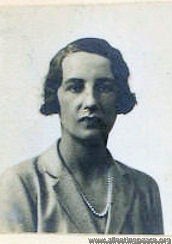
Née Reid
b. 3 Nov 1897 in Montreal, Canada; the "beautiful" [so said Harald Penrose] wife of Alan Butler.
(later, the 'Flying Grandmother', oh well...)
Her first husband having died in 1923, she married Alan Butler in 1925; together they had a daughter and a son.
15th in the Women’s Combined Alpine Skiing at the 1936 Winter Olympics, skating for her native Canada (although she was a member of the British Team before that).
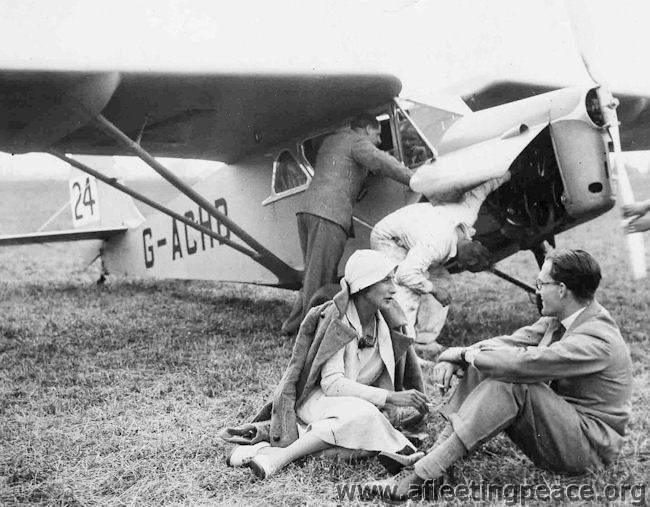 King's Cup 1933
King's Cup 1933Post-WWII, the Butlers moved to Rhodesia and bought a tobacco farm, but eventually moved back to Studham Hall, Bedfordshire.
She owned a 1930 DH.80A Puss Moth G-ABGX, which was sold in France in December 1934, re-registered as F-AMRX and whose registration was finally cancelled in 1936.
d. 17 Aug 1970 in Piraeus, Attiki, Greece from a heart attack while on holiday, and is buried in Studham.
-
Carberry, Maia
Maia Carberry
wife of John (Lord) Carberry.
In September 1927 Alan Butler (with Peter Hoare as passenger), and Hubert Broad, who took Maia, went to Venice to support the British Team in the Schneider Cup in Venice.
In case you were wondering, "Mrs. Carberry wore a pale blue leather flying helmet to match the colour of her Moth aeroplane."
She owned:
a 1927 Fokker F.XI, G-EBUT VP-KAB/VH-UTO 'Miss Africa', and
a 1927 DH.60X Moth, G-EBSQ, in which she was killed in an accident in Nairobi on the 12 March 1928.
-
Cleaver, Adelaide Franklin
Adelaide Franklin Cleaver
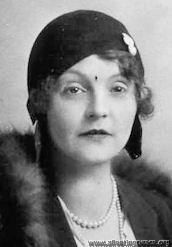
b. Adelaide Pollock in Northern Ireland in c.1885, the daughter of the Minister of Finance.
Adelaide (a.k.a. Mrs Hylton Spenser Cleaver) spent 3 months in 1929 flying to India and back, in her DH60G Gispy Moth G-AAEA. She was piloted by Captain Donald Drew, of Imperial Airways, and arrived back at Croydon on June 10th.
Here they are, lunching in the desert:
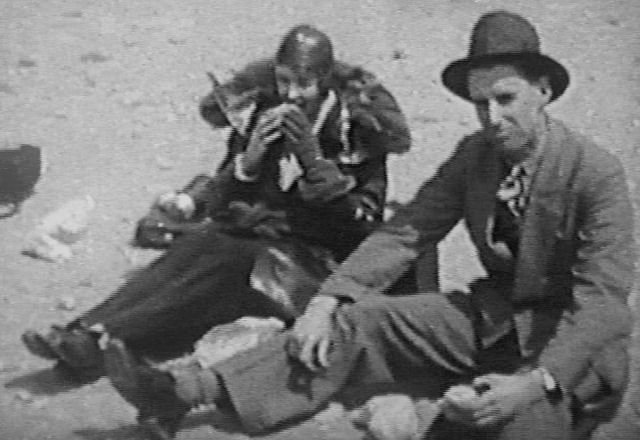
They had travelled as far as Egypt with Leonard Slatter, who was flying his newly-delivered Bluebird to Cape Town.
She didn't get her RAeC Certificate until June 1930, so I suspect he did most of the flying on that trip. However in Ocotber 1930 she made probably her greatest achievement - her flight from New York to Hollywood in her Moth, which she took with her on a steamship.
In July 1933, she was responsible for a "well-organised Flying Display which was held at Aldergrove Aerodrome, Co. Antrim. Her avowed intention was to stimulate air-mindedness in Ulster, and from the number of spectators who went to see the Display there is little doubt that she succeeded. We gather that from every point of view it was a great success."
In 1934, Mary de Bunsen wrote that "Mrs Spencer Cleaver makes the usually fatiguing journey to Northern Ireland three or four times a year in her own aeroplane, and, fitted with extra tanks to save refuelling during the day, it has many times enabled her to breakfast in London, shop in Paris from 11 to 1, and return in plenty of time for dinner at her house in London."
She owned:
a 1929 DH.60G Gipsy Moth, G-AAEA, which she sold to Venetia Montagu;
a 1930 DH.60G Gipsy Moth G-AAVY, which she sold to Lady Howard de Walden;
a 1930 DH.80A Puss Moth, G-ABFV, and
a 1933 Percival D.2 Gull Four IID, G-ACIP.
d. 14 August 1939 at Cooden, Sussex 'after a long illness', aged 54.
-
Elliott-Lynn, Sophie
Sophie Elliott-Lynn / Lady Mary Heath
Royal Aero Club Certificate No. 7975 (4 Nov 1925)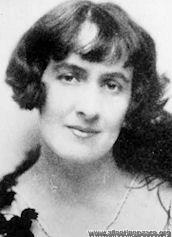 in 1925
in 1925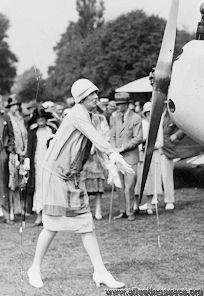
Lady Heath at Roehampton
b. Sophie Catherine Theresa Mary Pierce-Evans on 10th November 1896 in Knockaderry, Co Limerick, Ireland; her crazed father beat her mother to death (with a stick) and was jailed for life, so she was brought up by her aunts.
A well-known, courageous, determined and forceful sportswoman, an athletic 6-foot tall Irishwoman 'never averse to publicity' (which earned her the nickname 'Lady Hell-of-a-Din') who was elected World Champion Lady Aviator by the USA.
At Stag Lane in 1926, Mrs Elliott-Lynn formed a small group owning a pale blue Moth, but was also the "somewhat erratic" pilot of an S.E.5...
...which she crashed a year later at Brooklands.
In the same year, when Lady Bailey and Mrs Geoffrey de Havilland hit the headlines with a world record climb to 17,283 ft, Avro countered with Mrs Elliott-Lynn climbing to 19,200 and making a 1,300-mile trip in a single day, during which she made 79 landings.
Then, her first husband Major Elliott-Lynn having died off, Sophie married Sir James Heath, Baronet, and thereby became Lady Heath.
"Lady Heath stepped from her tiny aeroplane at Le Bourget after her long flight from the Cape in May 1928, as fresh as a daisy. 'It is so safe that a woman can fly across Africa wearing a Parisian frock and keeping her nose powdered all day.' This was the first solo flight from any overseas Dominion to Britain, and she was the first woman to pilot an aeroplane from Cape Town to London.
Unfortunately, Sophie was not very good with Sir James' money; she was rather too easily persuaded to "buy a lot of things" and send him the bill. Having given her £20,000 as a marriage settlement and bought her an aeroplane, he was eventually obliged to take out a note in the newspapers forbidding her to "pledge his credit". The marriage was dissolved in 1932.
Having fled to America, Sophie finally became plain Mrs Williams; he was an airman from Kentucky.
d. 9 May 1939, aged 42, in London when she fell down the stairs of a tramcar. She left £204.
Sophie owned, at various times:
the 1925 prototype DH.60 Moth (G-EBKT), also
a DH.60 Moth G-EBMV,
an RAF SE5A (D7016, G-EBPA),
a 1927 Avro 594 Avian I G-EBQLA,
a 1927 Avro 594 Avian IIR3 G-EBRS,
a 1927 Avro 594 Avian IIIR3 G-EBUG 'for the use of Miss Earhart',
a 1928 DH.60X Moth G-EBZC, and
a 1929 DH.60G Gipsy Moth G-AASY. -
Fairweather, Margaret
The Hon Mrs Margaret 'Margie' Fairweather 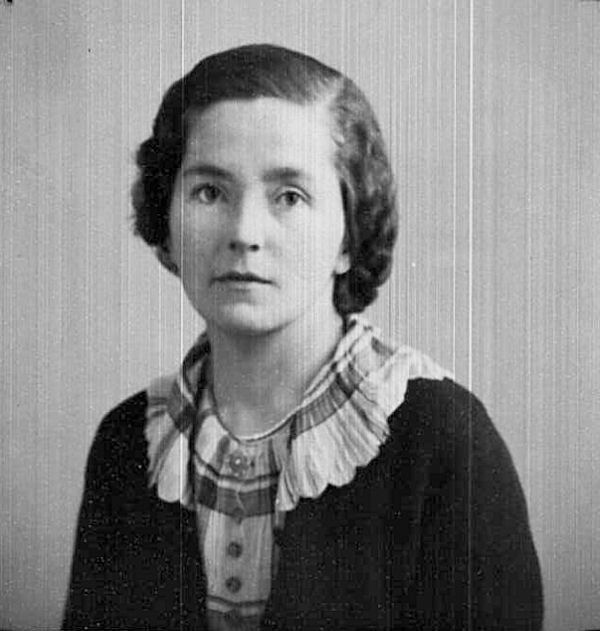 RAeC 1937
RAeC 1937b 23 September 1901 in Northumberland, the eldest daughter of Lord Walter and Lady Hilda Runciman.
Her brother Walter (co-Director, with Connie Leathart (q.v.), of Cramlington Aircraft, First Director-General of BOAC, Commodore of the Royal Yacht Squadron, OBE, etc, etc) became the 2nd Viscount Runciman of Doxford, and her sister Katherine ('Kitty') was adjutant for the Women's Section of the ATA from March 1941.
I sometimes feel that Margie gets a bad press; she was, apparently, quiet and rather withdrawn, (nicknamed 'Mrs Cold Front') and, in photos, always seems to have that far-away look in her (green, btw) eyes. But, her ability, and her devotion to duty and to her friends, were never in doubt.
She got her RAeC certificate in 1937. In fact, she acquired her first aeroplane from her brother Walter; a 1931-reg D.H. Puss Moth G-ABLG, which he had flown in two King's Cup races.
She had married Roderick Nettleton King-Farlow in July 1925. Their daughter Ann was born in 1931, but they divorced in 1936, and she then married Douglas Keith Fairweather in March 1938. He was a businessman from Glasgow, and her complete opposite - outgoing, irreverent, and very eccentric.
Margie then sold her aeroplane, and she and Douglas re-registered his Puss Moth G-ABYP in their joint names. Later they also bought a Leopard Moth, G-ACXH.
She had a horrible experience in 1939 when her friend, Dr. Elizabeth Cook, was killed by walking into the propeller of the aeroplane Margaret was about to pilot; they were going to fly to Paris for a holiday, and the plane was standing with the engine ticking over.
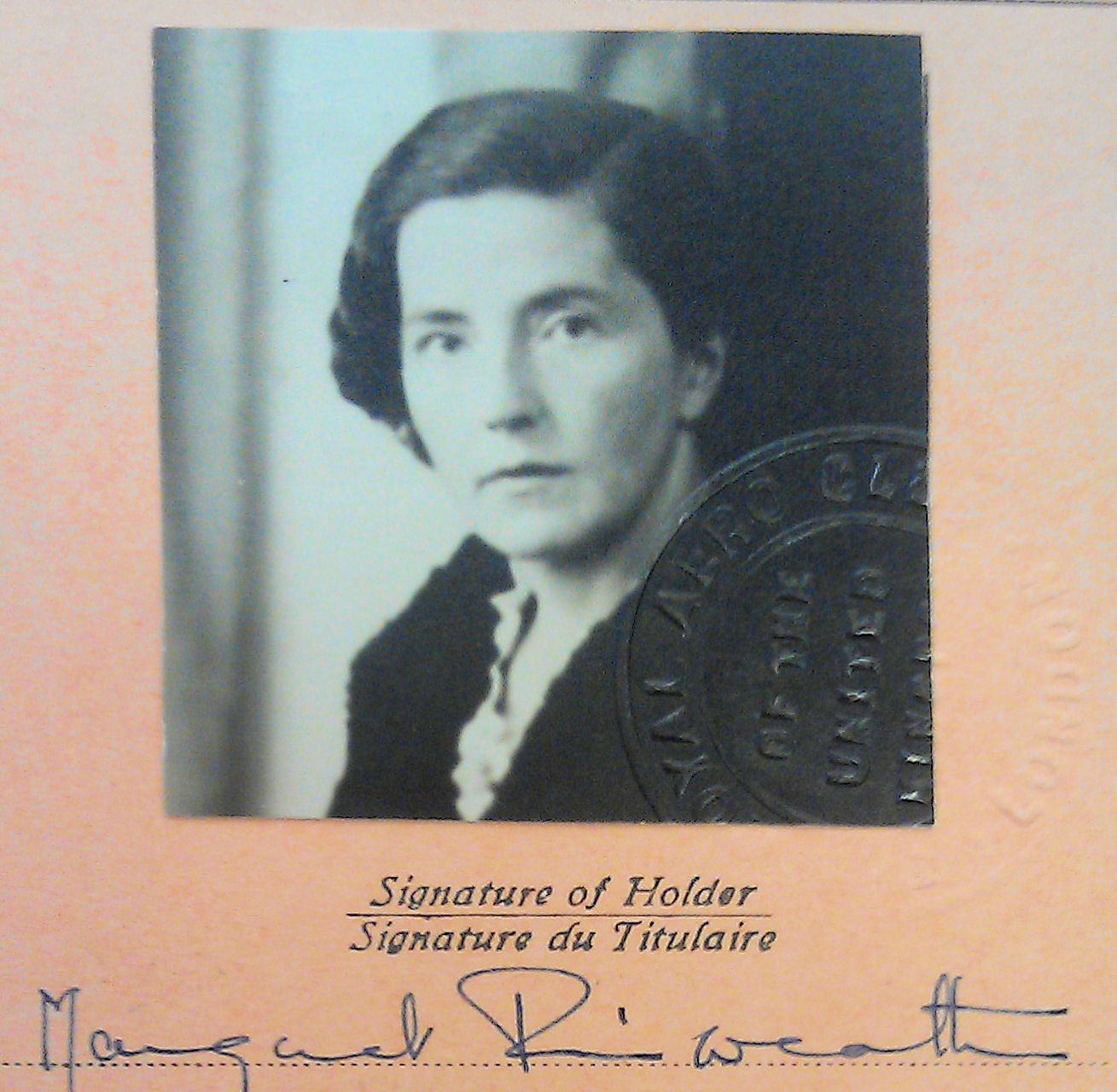 FAI 1939
FAI 1939So, prior to WWII she was one of the most experienced women pilots in the country, with 1,050 hours of civilian flying, and (from late 1937) was an instructor with the Scottish Flying Club. She had flown Miles Whitney Straights, D.H. Moths, Puss Moths, Tiger Moths, Fox Moths, Leopard Moths, Hornet Moths, Dart Kitten, Taylor Cub, Potez, and Percival Vega Gull, in Belgium, Holland, Germany, Sweden, Denmark, Hungary, Czechoslovakia, France Switzerland and Austria.
Not surprisingly then, she was one of the 'First Eight' Women ATA pilots at Hatfield, starting in January 1940.
Here story continues here: Fairweather, Margaret (W.7) (ata-ferry-pilots.org)
-
Gault, Dorothy Blanche Hamilton
Dorothy Blanche Hamilton Gault 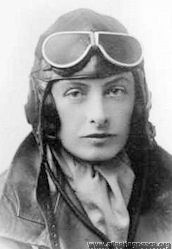 Lady G-AAGA
Lady G-AAGADorothy Shuckburgh as was, Andrew's (q.v.) second wife.
"An owner-pilot, Mrs Hamilton Gault, has with her husband travelled England and the Continent for four years in a Moth rejoicing in the registration letters 'G-AAGA'.
She is an example of the practical lady pilot whose aeroplane is used, when weather permits, for all travelling in England and abroad. Once a week or more, in summer, she flies to London and back to her home in Somerset.
She is, however, forced to use the aerodrome at Yeovil - some distance from her home - owing to the lack of landing grounds in the Somerset Hills, which keeps a number of air-minded people in the county from taking up flying."
Dorothy died in 1972, at Hatch Court
-
Gower, Pauline Mary de Peauly
Pauline Mary de Peauly Gower MBE 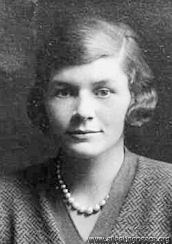 1930
1930b. 22nd July 1910 in Tunbridge Wells; younger daughter of Sir Robert Gower, M.P for Gillingham, Kent.
5 feet 5 in height, in case you wondered.
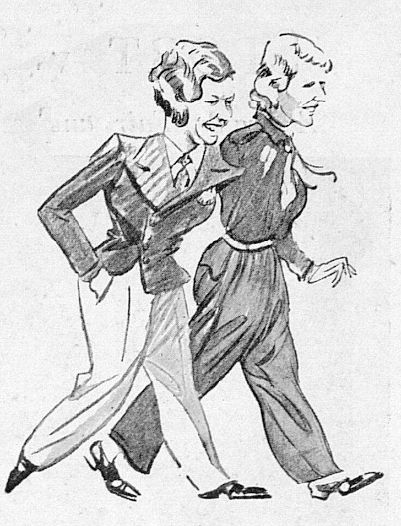
The Bystander Special Aviation Edition, 1933
"In England you can count on one hand the women who are making a living directly from flying. Probably foremost among them are the two girl flyers, Pauline Gower and Dorothy Spicer, who work in partnership at joy-riding. Miss Gower is the pilot and Miss Spicer the mechanic." - Amy Mollison, writing in 1934
"Pauline Gower, one of the few women who has already achieved a successful commercial flying career, did joyriding last year in 185 different towns with a travelling air circus." - Mary Bertha de Bunsen
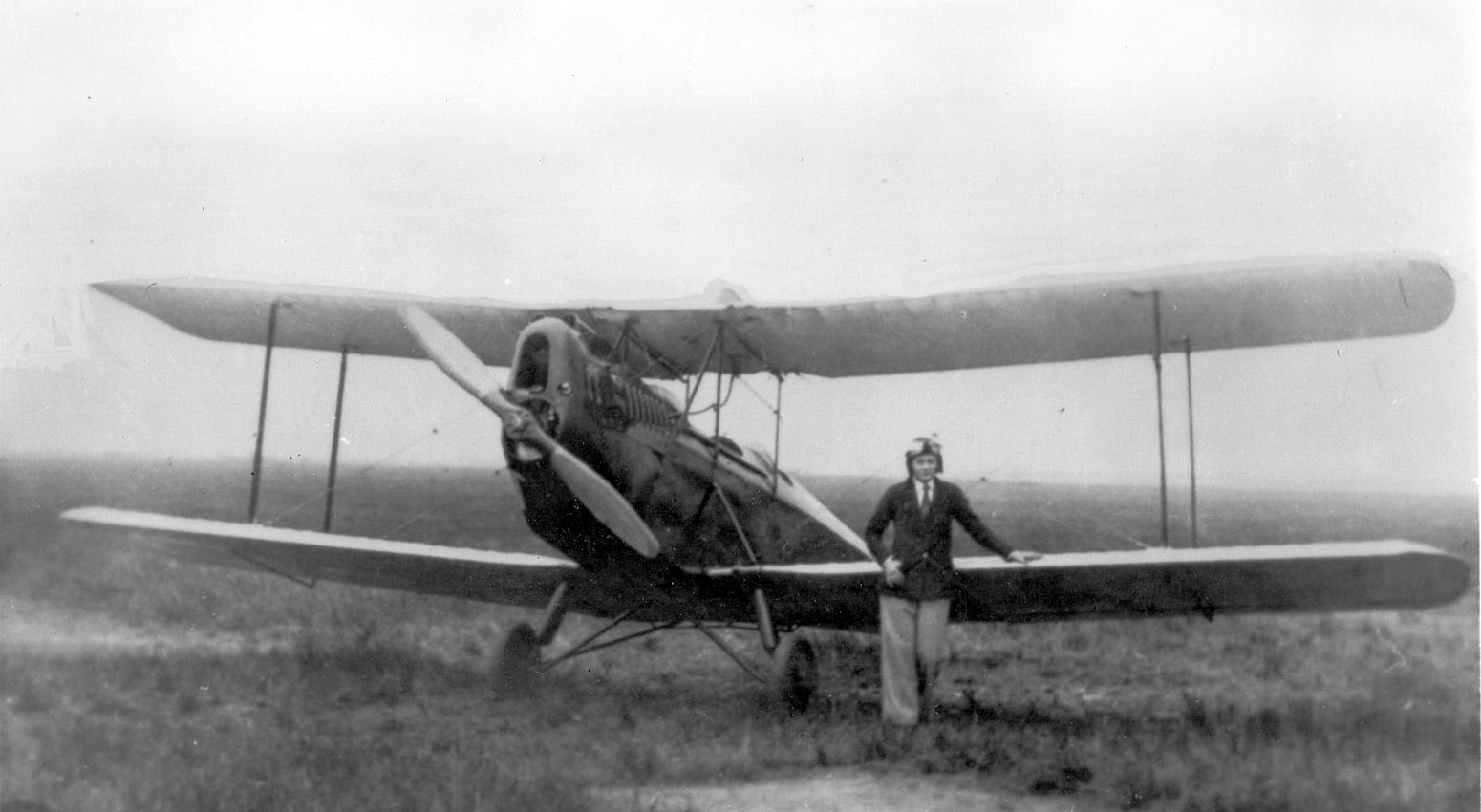 1932
1932She was fined £222 in 1933, having taxied her Spartan into a stationary Moth at Cardiff while giving joy-rides in an air pageant (although she reckoned it had definitely moved since she checked where it was). Three years later, she was taken to hospital suffering from concussion and 'lacerations of the scalp' after she... collided with another aeroplane on the ground, this time at Coventry airport.
During her air-taxi career, she was reckoned to have piloted more than 33,000 passengers.
In 1937 she, Amy Johnson and Dorothy Spicer invited "all women pilots interested in the idea of a central meeting-place for women aviators in London" to write to them, but I don't think it ever happened.
Founder and first Commandant of the Women's Section of the Air Transport Auxiliary in 1940; from 1943, a board member of BOAC. She had a narrow escape in August 1943 when 'Fortuna', an old Imperial Airways airliner, with her and 7 other BOAC officers aboard, made a forced landing near Shannon and was written off.
See here for more: Gower, Pauline Mary de Peauly (W.25) (ata-ferry-pilots.org)
Married Wing Commander William Cusack Fahie in June 1945, but died of a heart attack in March 1947 giving birth to twin boys, one of whom, Michael, later published 'A Harvest of Memories' about her.
She owned:
a 1929 Simmonds Spartan, G-AAGO, (the one which she wrote off in the taxying accident in Cardiff in August 1933), and then
a 1931 Spartan Three Seater, G-ABKK, the one which she wrote off in the taxying accident at Coventry in May 1936.
-
Green, Sheila Macdonald
Sheila Macdonald Green 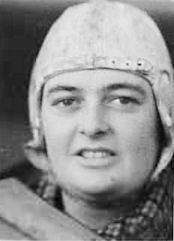
b. 5 Feb 1901 in Elgin, Scotland but living in Maidstone, Kent, owned a 1929 Klemm L25 Ia, G-AATD -
Greenall, Josephine
The Hon Mrs Josephine Greenall 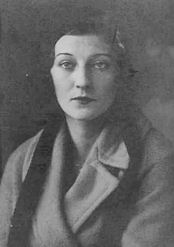
nee Laycock, b. 28 Jun 1908, from Melton Mowbray, owned:
- a 1930 DH.60M Moth, G-AAVE, later sold and re-registered VT-ANS
- a 1931 DH.80A Puss Moth G-ABLC, Sold abroad in 1938
Her husband, the Hon. Edward Greenall, was 2nd Baron Daresbury. -
Guest, Diana
Miss Diana Guest
Royal Aero Club Certificate 8756 (27 Aug 1929)
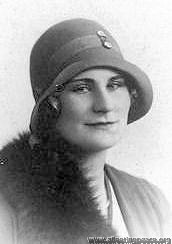
photo: 1929, aged 20
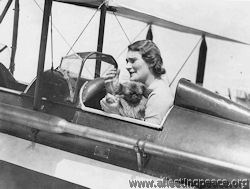
Frederick's daughter; later sculptress Diana Guest Manning. [Mr Manning was one of her 3 husbands].
"I was born and brought up in the country in England. My parents, Amy Phipps and Frederick Guest, met in India and married a year later in London. They settled in a beautiful Queen Anne house near Oakham named Burley on the Hill".
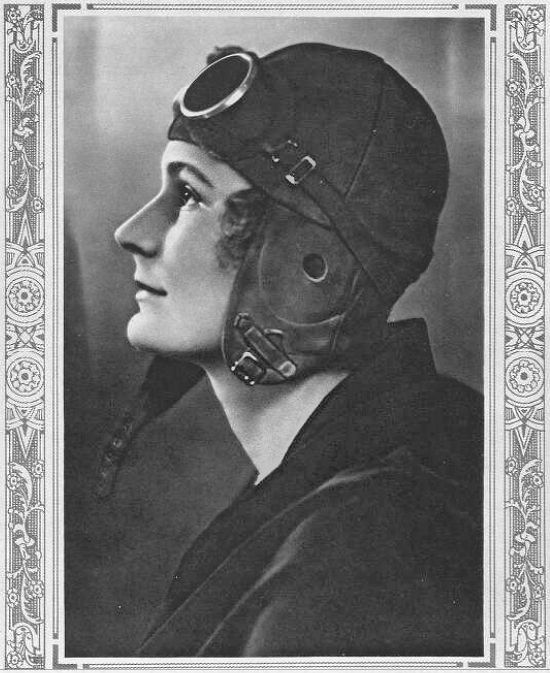
"AN ATALANTA OF THE AIR - MISS DIANA GUEST, CAPTAIN "FREDDIE" GUEST'S PILOT DAUGHTER.
Miss Diana Guest, the young daughter of Captain the Hon. Freddie Guest, P.C., C.B.E., D.S.O., etc., Chairman of the National Flying Services, was born in 1909, and recently made her debut in society. She has also just made her debut in the air, and took her pilot's A certificate recently. She and her father had their flying lessons at the same time, and took their respective tickets simultaneously for although Captain Guest, who was born in 1875, has long been interested in flying, and was Secretary of State for Air from 1921-1922, he was not the holder of a pilot's A certificate. "
The Sketch, 1929
In 1981 "Miss Guest, who divides her time between Paris and Palm Beach, Fla., and whose works have been exhibited in museums around the world, has donated 27 pieces of her sculpture to Old Westbury Gardens".
Diana owned:
- 1929 Hawker Tomtit G-AALL, then
- 1930 DH.80A Puss Moth, G-AAZP, which later became SU-AAC in Egypt and was impressed in WWII as HL537.
d. 1994
-
Johnson, Amy
Amy Johnson (Amy Mollison)
Royal Aero Club Certificate 8662 (28 Jun 1929)
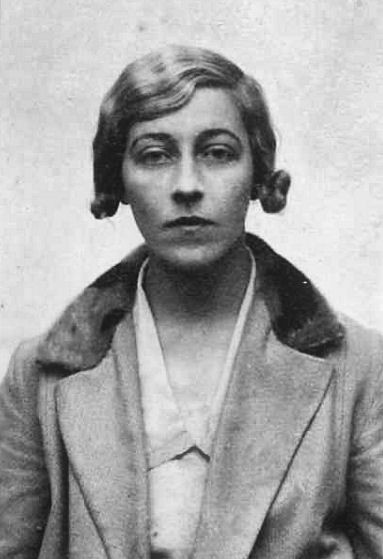 1929
1929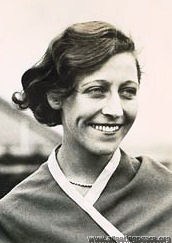
1934
Amy Johnson, Hull's Finest
a.k.a. Amy Mollison
Born 1st July 1903 in Kingston upon Hull; Amy was 'a slight young woman with heavily lidded eyes, dentured teeth, a shy smile and a soft Yorkshire accent' [she later developed a rather fake upper-class BBC one, possibly under her husband Jim's influence].
By 1929, a secretary (albeit one with an economics degree, and an engineer's licence to go with her aviator's certificate) turned solo record-breaking pilot and all-round nation's sweetheart. Married for six years to Jim Mollison (which was a Big Mistake).
On May 26th, 1932, after her solo flight from America, Amelia Earhart was the guest of the Royal Aero Club in London, and amongst the ladies in attendance were Lady Bailey, Amy, and Winifred Spooner (less than a year before her untimely death).

Air Transport Auxiliary in WWII (Died in Service)
Amy's aircraft included:
a 1928 DH.60G Gipsy Moth (G-AAAH) which she named 'Jason', and is now in the Science Museum;
a 1930 DH.80A Puss Moth, G-AAZV, 'Jason II';
a 1930 DH.60G Gipsy Moth, G-ABDV, er, 'Jason III'.
After 1930 she owned:
a 1932 DH.60G III Moth Major, G-ABVW,... ummm, let me guess... yes... 'Jason 4', and
a 1932 DH.80A Puss Moth, G-ACAB, 'The Desert Cloud'.
-
Lambton, Ethel Ruth
Ethel 'Ruth' Lambton 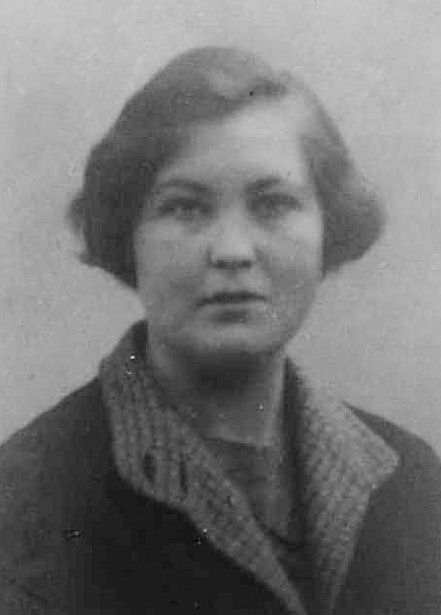 1930
1930b. Ethel Ruth Nicholson in Shepperton, 5 Jun 1913. Her parents were Capt William Henry Nicholson and Sybil Wigham.
Educated at Roedean, got her 'matric', and went into welding research as an engineer, working for Arc Manufacturing Co. in Shepherd's Bush.
She married John Lambton in March 1934, and they had one son.
In 1937, she and the Hon. Ruth Cokayne took a 'light-hearted summer tour' to Budapest (via Brussels, Cologne, Munich, and Salzburg) in a Gipsy Moth; a trip which they reckoned cost them about £55 each in total.
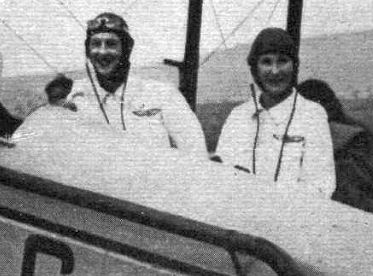 Ruth C (l) and Ruth L (r) ('Flight')
Ruth C (l) and Ruth L (r) ('Flight')They muddled along in a breathless, schoolgirlish sort of way. In Frankfurt, all their possessions were confiscated but then 'we found ourselves in the officers' mess, where the entire squadron shook our hands with the utmost solemnity, clicked heels, Heiled Hitler and gave us lunch! Another round of handshakes, our belongings were duly returned to us, and we Heiled Hitler gratefully ourselves as we took off'.
She was an early recruit to the Air Transport Auxiliary (ATA) in 1940, starting on the 25th June as W.20 - the 20th woman employed by the ATA. (Ruth Cokayne also joined the ATA, as W.40, in April 1941). see Lambton, Ethel Ruth (W.20) (ata-ferry-pilots.org)
-
Leathart, Constance Ruth
Constance Ruth Leathart
Royal Aero Club Certificate No. 8085 (18 Mar 1927)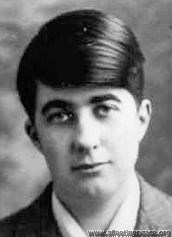 in 1927, aged 24
in 1927, aged 24b. 7 December 1903 in Low Fell, County Durham; known as 'Connie'.
"Five foot three and of generous proportions" (Lettice Curtis);
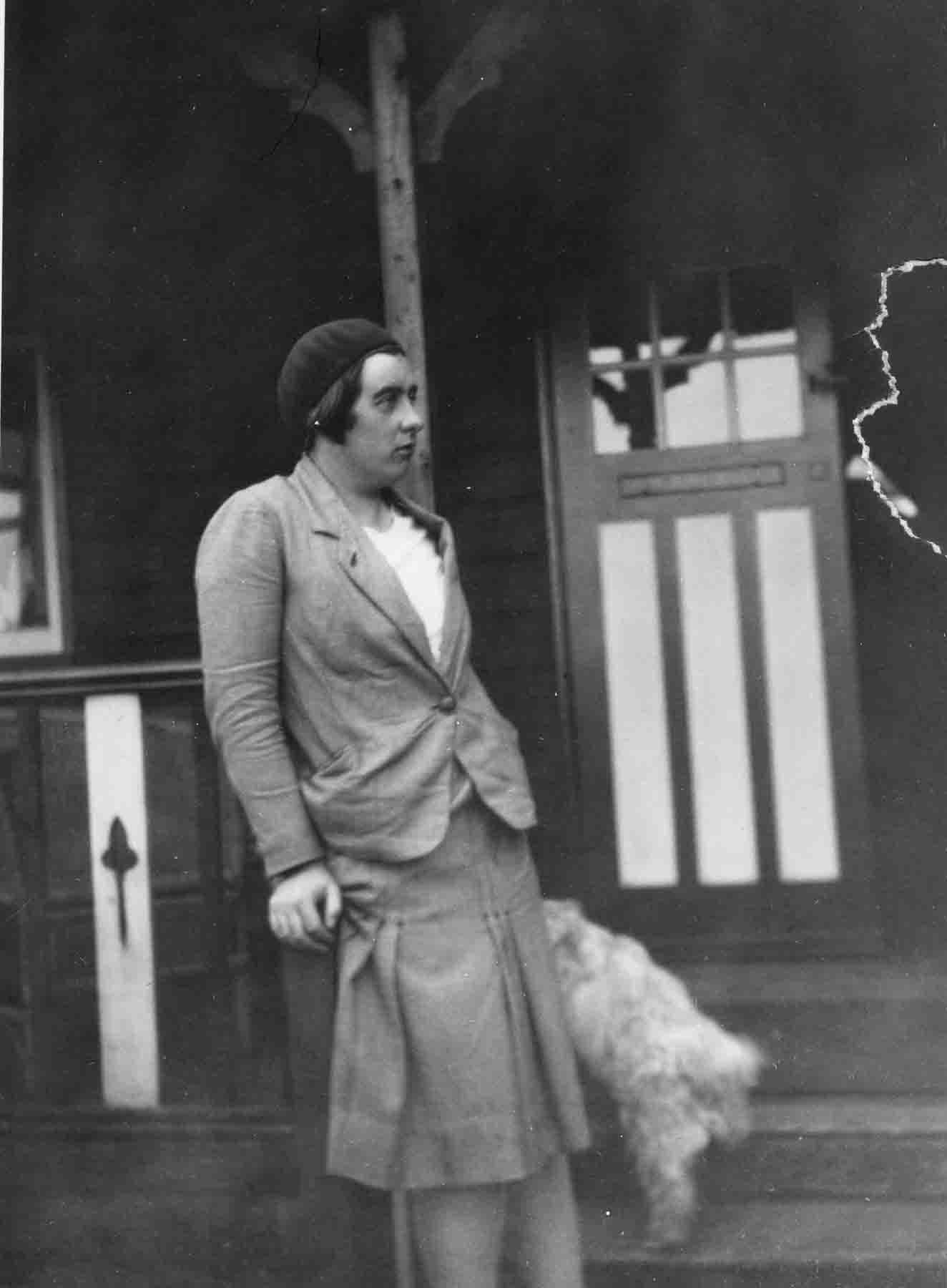
[Check]
"a very experienced pre-war racing pilot and... looked like George Robey" (Mary du Bunsen).
[I'm not so sure this is fair... here's a picture of George Robey for comparison:
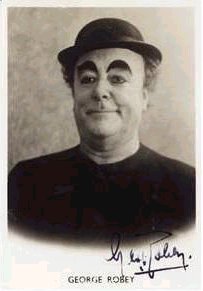
Hmmm...]
"One of the first 20 British women pilots to obtain the RAeC certificate"
[Amazing - as Connie got her certificate No. 8,085 in 1927, 14 years after the first woman pilot Hilda Hewlett - but true; she was only the 12th woman to get an RAeC certificate]
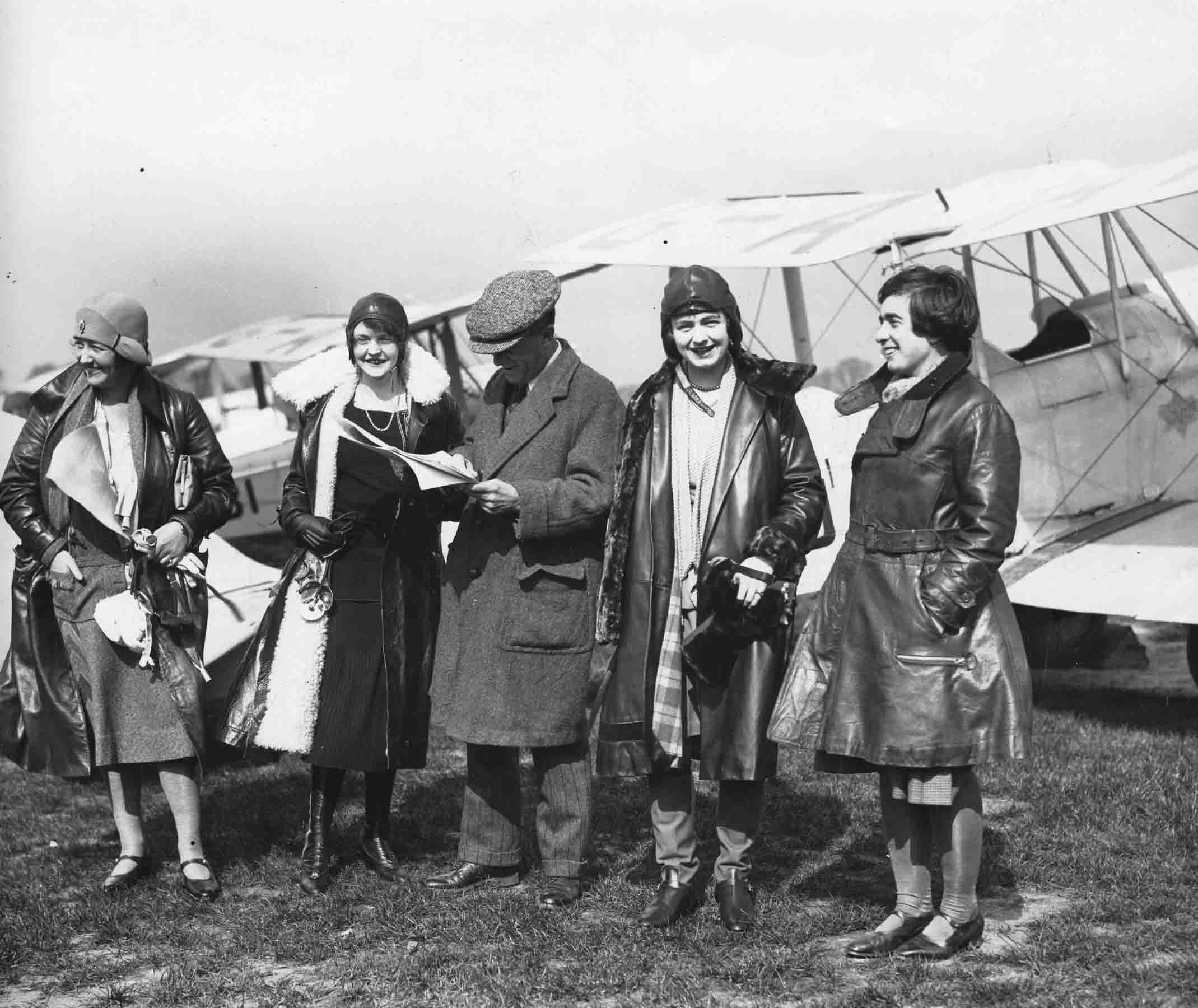
l to r Edith Chalmers, Adelaide Cleaver, Sir Sefton Brancker, Rosalind Norman and Connie before the start of the 1930 Heston Spring Flying Cruise to Germany
In the late 1920s and early 1930s, with Leslie Runciman (q.v.), she ran Cramlington Aircraft, a company which repaired damaged aeroplanes. She also designed and flew her own glider.
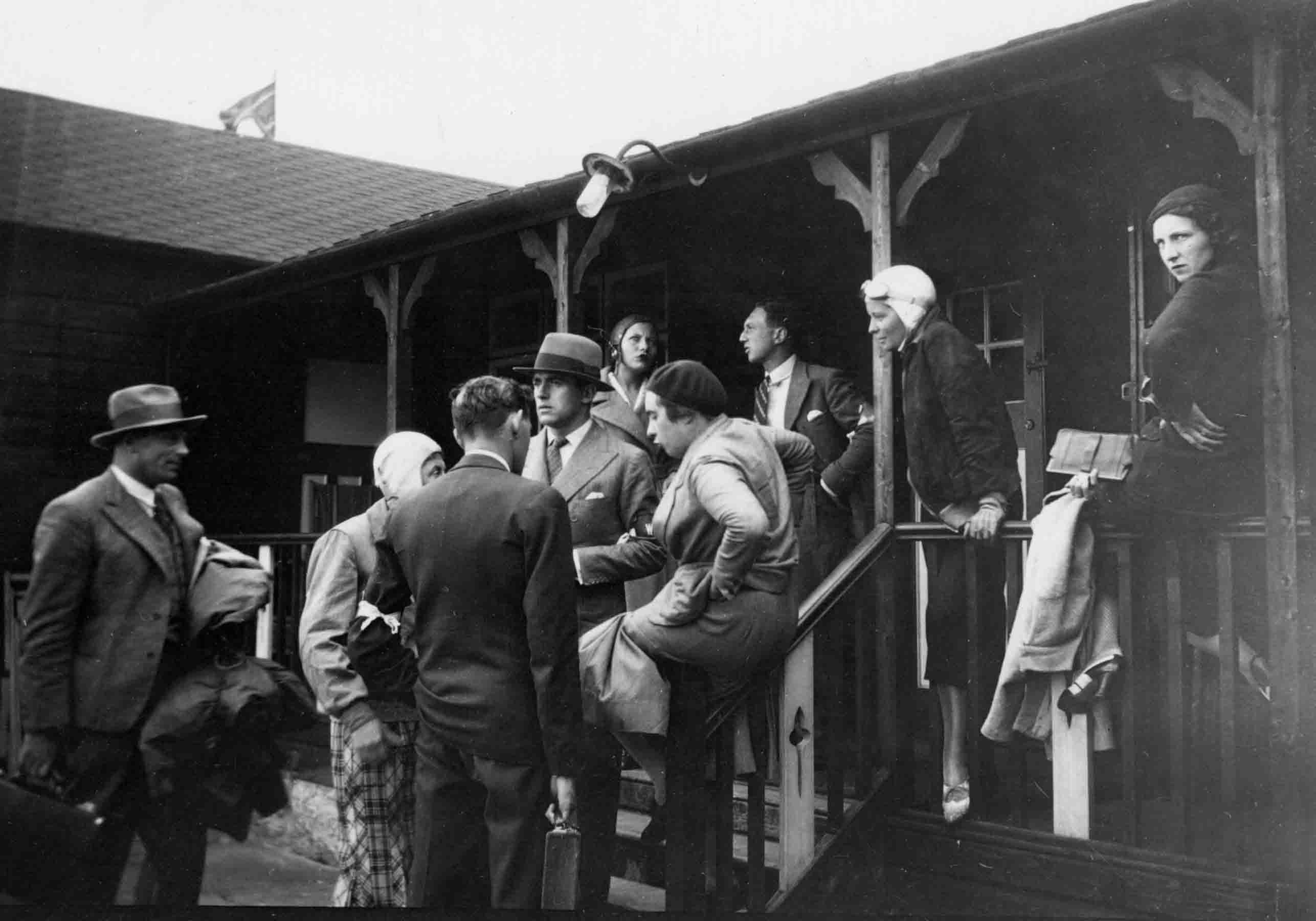
Leslie Runciman and Connie (centre)
She was educated at Cheltenham Ladies College, and then Ethelburgas School back in Newcastle. By 1939, her mother had moved to Ottery St Mary in Devon, but Connie was still in the north-east, at Morpeth in Northumberland.
In December 1939, aged 35, working in the map department at Bristol Airport, she applied to join the Air Transport Auxiliary (ATA). Her experience at the time was over 700 hours, making her one of the most experienced women pilots in the UK, so she started as soon as they could sort themselves out (Pauline Gower was only allowed to take on 8 women to begin with)... which turned out to be August 1940. She was 'W.13' - the 13th woman pilot taken on by the ATA.
Air Transport Auxiliary in WWII
---
The Times wrote "She continued flying until 1958 when, reluctantly, she finally disposed of the last of her aeroplanes.
Connie Leathart remained a reserved, private person who shunned any form of publicity. In a sense this was a pity as many of her feats went unremarked. In retirement she farmed in Northumberland, where she bred Kyloe cattle [actually, it seems that "she did not breed Kyloe cattle; she did once have a couple of them, but both were bullocks"] and raised sheep. An accomplished horsewoman throughout her life, she continued into her fifties to ride regularly to hounds with the Morpeth and Tynedale hunts. She never married."
A friend of hers tells me: "I knew her for the last 20 years of her life, she was my parents' employer and my grandparents' before them. An amazing and eccentric and very kind lady."
Died 4 November 1993 in Northumberland, aged 89
...
and John G D 'Jack' Armour (q.v.), who was her first flying instructor in the ATA, was her cousin(!)
Connie owned
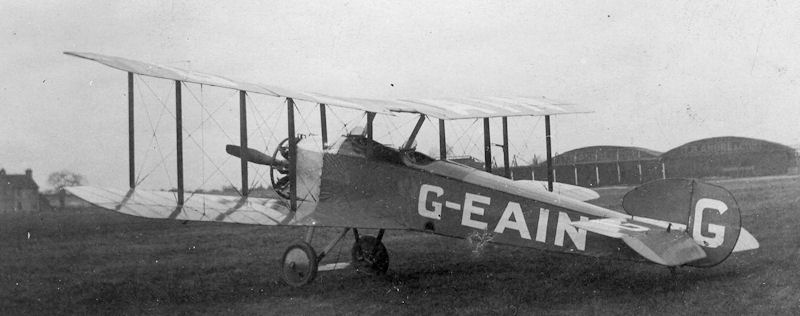 RAeC
RAeCthe 1922 Sopwith Grasshopper (WO 2698, G-EAIN, the only one ever built, which she acquired in 1928),
a 1927 DH.60 Moth (G-EBRX, later PH-KLG),
a 1929 Westland Widgeon IIIa (WA1776, G-AAJF), and
a 1932 Comper Swift, G-ABUU.
-
Mackay, Elsie
The Hon. Elsie Mackay (a.k.a. Poppy Wyndham)
Royal Aero Club Certificate No. 7930 (14 Aug 1922)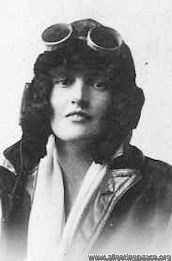 1922
1922b. Simla, India, in 1893, the third daughter (of four, plus one son) of Lord and Lady Inchcape; the "friendly, sociable and unpretentious" Miss Elsie from Glenapp Castle in south-west Scotland.
One of the richest women in Britain, and therefore a member of the Court and Social whirl: e.g. aged 19 or so, she was at Mrs Tennyson d'Eyencourt's dance in 1912: "The drawing room in which the dancing took place was decorated with tulips in different shades of yellow" and all that.
Became a nurse in her mother's hospital for wounded soldiers (this is all sounding a bit Downton Abbey, sorry) and in 1917 nursed a certain wounded South African soldier Mr Dennis Wyndham, in civilian life An Actor. She told her father she wanted to marry him; Daddy strongly opposed the marriage; they ran away to Glasgow (Glasgow??), took apartments and got her landlady and someone else to act as witnesses; went to the registrar... hang on, this is Downton Abbey!
Unfortunately for them, they hadn't been resident in Scotland for the required 15 days, and the marriage was declared null and void. The judge was very put out... "This sort of thing will not do. People must realise this is a solemn act dealing with the question of marriage and the future of a man and woman... I am going to report the whole of this matter to the Lord Advocate".
Elsie reverted to her maiden name, went back to the family home and to the endless balls, dinner-parties, at-homes, receptions, hospital ward-openings, society weddings and cruises. "Miss Mackay wore a Victorian picture dress of pink and gold brocade over an underskirt of silver lace"... She became quite a well-known interior designer for P&O. Lord Inchcape was chairman of P&O but that was just a coincidence, probably.
Meanwhile... in April 1920 a certain Miss Poppy Wyndham appeared in a horsey silent picture movie called 'A Dead Certainty'... June 1920, Poppy Wyndham (again on a horse) in "A Great Coup"... August 1921, Poppy Wyndham in "A Tidal Wave". As 'Poppy', Elsie appeared in at least 8 movies between 1919 and 1921.
In June 1924, Elsie sold programmes at a charity matinee at the Aldwych Theatre; the following month, presided at the Catholic Stage Guild, and in June 1926, she sold "sweets and programmes under Lady Alexander's direction" at another charity matinee.
On the 9th March 1928, she denied rumours that she was going to accompany one-eyed Imperial Airways pilot Captain Walter George Raymond Hinchliffe on a transatlantic flight; she knew him, of course, but only had "a very small financial interest in [his flight]".
Sure enough, on March 14th, the black and gold Stinson-Detroiter aeroplane 'The Endeavour', containing Capt Hinchliffe and Elsie Mackay, took off from Cranwell. It was spotted 170 miles off the west coast of Ireland, heading out over the Atlantic. They were never seen again...
...except...
1) a note, found in a bottle at Flint, North Wales, saying "Goodbye all. Elsie Mackay and Captain Hinchcliffe. Down in fog and storm". Pity the handwriting was nothing like Elsie's, and the writer spelt Hinchliffe's name wrong, but anyway...
2) A London spiritualist received a message from the dead Mr Hinchliffe in July: "We landed on the water. We did not crash... I swam for 20 minutes but the currents were too strong and I became unconscious and drowned. Mackay's end was peaceful". I only report this stuff...
3) Finally, in December an identifiable wheel from the aircraft was found washed up in Ireland (which rather settled it).
Lord and Lady Inchcape generously put Elsie's £521,101 13s 4d in trust for the nation for about 50 years, after which time they hoped it "should be used to reduce the National Debt". They also gave Capt Hinchliffe's widow Emilie (sometimes known as Eileen) £10,000, his estate being a rather more modest £32.
In 1977, when the Elsie Mackay Fund matured, it had grown to over £4.5 million; the National Debt had also grown a bit, however. To £66.8 billion. Or, to put it another way, just another 99.993% to go...
See also:http://www.elsie-mackay.co.uk/ and 'A Flight Too Far', by Jack Hunter/Stranraer and District Local History Trust, 2008.
There is a memorial window to Elsie in Glenapp Church.
[p.s. this is not the same actress, called Elsie Mackay, who was married to actor Lionel Atwill; she was American]
Elsie owned a 1916 Airco DH.6 (C5220, G-EAGF)
Page 1 of 2

